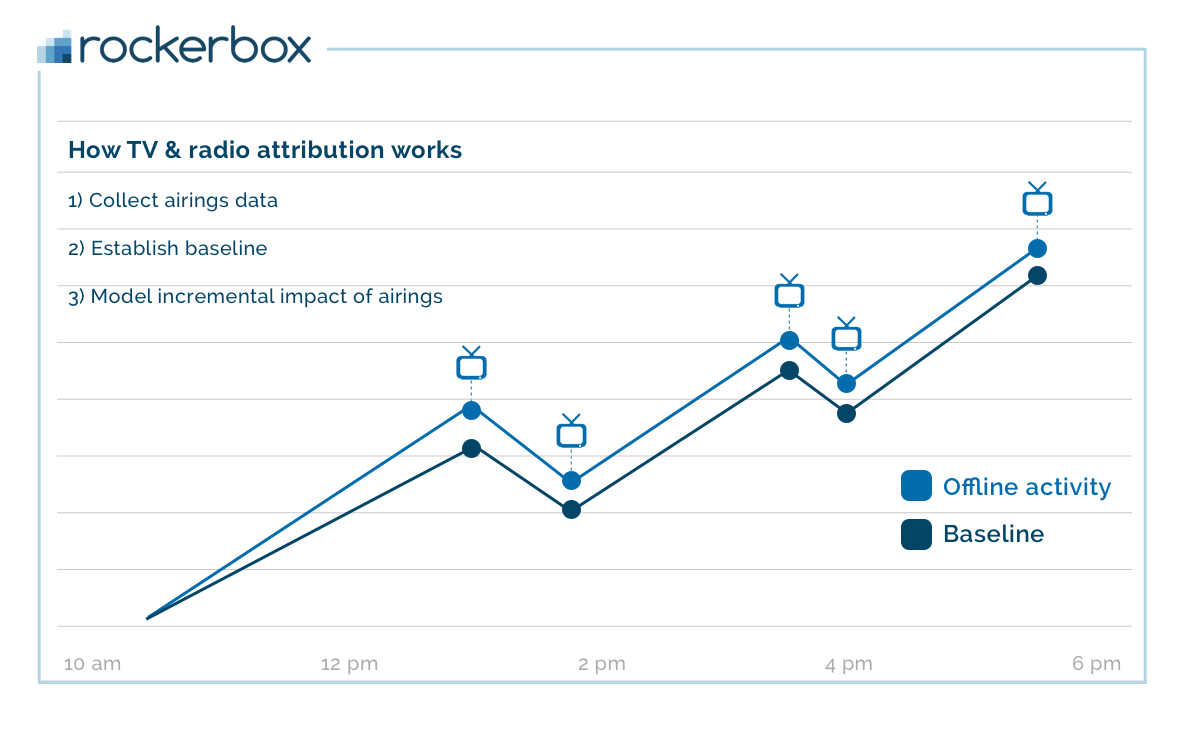If you’ve considered running TV or radio ads, then you've questioned how to measure their impact on conversions.
Maybe you’ve thought about sending surveys asking customers how they’ve heard about you, but what percentage of your customer base will actually complete it?
Even more, how do you know which specific ad spot or program led to any action?
A common three-step process
While the specifics around attributing TV or radio ads vary across every platform, the basic process is similar across the board.
1) Gather airings and online response data: Platform gathers data on when TV or radio ads are running down to the hour and minute level. (This is commonly known as post-log data.) Online response data (e.g., site activity) is also collected.
2) Estimate baseline: Platform estimates a baseline, or conversion activity in the absence of any media. You can also think of this as the “weights” assigned to each marketing touchpoint prior to TV or radio activity, as determined by your attribution model.
3) Model the incremental impact of airings: Platform evaluates the impact of your ads above your baseline that was measured out. This typically means that attribution models re-run to determine the value of the TV or radio touchpoint.

Where this gets complicated
The process above seems simple, but a number of pieces complicate it.
First, how do you who was exposed to a TV or radio ad? You could say that 100% of site visitors within a certain timeframe and location were exposed, but this usually far from accurate. In some cases, ad exposure data can be matched to the household.¹ In other cases, a heuristic approach is used to only include a percentage of visitors. Maybe this means only counting net new visitors within 20 minutes of ad exposure. Over time, 20 minutes may become 4 minutes, based on survival curves from your data.
Next, what happens if you run multiple spots that overlap each other? What happens if an ad runs on a less popular network with lower impressions, and the model can’t pick out a clear spike? Many attribution platforms will handle these scenarios by grouping similar spots together in order to amplify the signal. Then, they’ll learn an individual response model for each of these groups.
Opening doors to optimization
As with all measurement, there are inherent imperfections. There is a limit to how precise TV or radio attribution can get. But that doesn’t mean it can’t improve your ad ROI greatly.
With the right offline attribution process in place, you can make several optimizations around your TV or radio strategy:
1) Network: Know where you should be advertising and identify wasted spend on underperforming channels.
2) Daypart: Know when you should run ads.
3) Geolocation: Know where your most engaged audiences are.
4) Creative: Know what types of content resonate best with your audience as well as optimal spot lengths.
5) Online campaigns: Know how offline ads influence online activity, e.g., organic search, paid search, etc. (Not every platform does this, but it’s very important for getting the full picture).
Over time, rather than stating “My ad resulted in 10 new clients", the results you get from TV or radio attribution is more like, “I’ve been able to increase the impact of my ads over the last 9 weeks”.
Offline attribution goes beyond TV and radio — direct mail, OTT, and print ads require their own methods for measuring impact. We’ll cover these later on.
¹https://www.iab.com/wp-content/uploads/2018/10/Advanced_TV_Attribution_IAB_Video_CoE_2018-10.pdf
 Google
Google Facebook
Facebook Instagram
Instagram TikTok
TikTok Snapchat
Snapchat Reddit
Reddit Pinterest
Pinterest


.png?width=50&height=56&name=medal%20(1).png)








